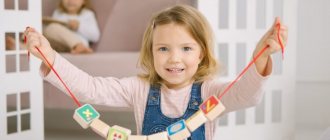Speech is the main means of communication among people. Therefore, it is so important that the child develops it correctly. One of the indicators is clear pronunciation of all sounds by the age of 5–6 years. And kids can’t do it without parental help. How to teach your child to say all the letters correctly? What should you do for this?
A bit of "general theory"
First of all, it is important to understand that a little person’s speech develops in stages. Experienced parents probably remember that in the first months of life their baby chanted vowel sounds, then began to hum, pronouncing syllables with simple consonants, then came the first onomatopoeia (“am-am”, “av-av”) and the first words.
- Closer to one year, the child can say “mom,” “dad,” “baba,” “uncle,” “give,” and perhaps several other words. He also uses the “wrong” words (“kup-kup”, “bye-bye”).
- From one to two years old, the baby learns to formulate the first simple sentences (“I’ll have soup”, “Dad, give me”). If the syntactic structure of a sentence (subject - predicate) can be traced, no attention is yet paid to the purity of sounds: the child’s articulatory apparatus is not yet sufficiently formed for this. But the so-called “passive” vocabulary, which began in the first months, is being replenished by leaps and bounds: the child learns to understand new words, remembers their pronunciation and meaning, although he does not yet know how to pronounce them. Later they will turn into his active speech. Now he no longer just pronounces the “vocabulary set”, but listens to how he says these words and the sounds in them, and is able to evaluate whether it is correct or not.
- Around 3 years old, a child learns to repeat short poems, as well as construct complex sentences with the words “because”, “which”, “so that”. Most often, it is at this age that whistling sounds (S, Z, C) “ripe.” But even if they are still being replaced (for example, by the sound T), but the child’s intelligence is developing normally (he understands speech addressed to him, knows the names of his relatives, or that animals also have mothers and fathers) - there is no reason to worry.
- By the age of 4, the child should know general words (what are dishes, transport, toys, clothes). The pronunciation may not yet be very clear (hissing and P are the ones that suffer most often).
- At the age of 5, a child must correctly pronounce all sounds, since by this time the parts of the brain responsible for the development of speech have been sufficiently formed, and the speech apparatus has reached the required “condition” (provided that the child has been constantly trained: speech itself is not will come “out of nowhere”).
How do sound pronunciation disorders manifest themselves?
If the baby pronounces sounds incorrectly, this may indicate dyslalia or dysarthria. These deviations have some differences. With dyslalia, the pronunciation of sounds of different groups is impaired - sonorant, hissing, front-lingual, and so on. Speech defects can manifest themselves in different ways:
- absence of sounds (omission of complex letters in the words “yoke” - “yoke”);
- replacing sounds (together with “R” the child pronounces “L”, for example “fish” - “lyba”);
- distortion of sounds (French “R”, side “W”, etc.).
Dyslalia often develops against the background of hearing loss. Children with hearing loss have difficulty distinguishing between whistling and hissing, dull and voiced sounds.
With dysarthria, the child pronounces consonants and vowels incorrectly. Improper breathing and decreased emotional expressiveness of speech are also observed. It is worth noting that disturbances in the pronunciation of sounds associated with dysarthria are more stable. Therefore, correction may require more time and effort.
Speech development and parental involvement
So what is parental help? First of all, it is important for adults to understand that it is impossible to simply teach a child to say letters. This process is long, systematic and comprehensive. Children’s speech develops along with the improvement of other skills: both psychomotor and physical. If the baby is behind in development (he started holding his head up late, sitting up, he has problems with memory, attention) - speech will most likely also lag behind.
What needs to be done to ensure that everything happens on time? Firstly, monitor overall development - train muscles, dexterity, motor skills, memory, attention.
The following aspects are especially important for developing speech skills.
- From a very early age, parents should speak to the child clearly and correctly: without childish touching “lisping”, without adjusting words to the child’s age. Yes, a baby can speak incorrectly due to age-related imperfections of his speech apparatus. But he should hear only accurate speech around him: correct, clear, literate, without verbal garbage (“well this”, “damn”, “in short”, “what”), otherwise the incorrect pronunciation will become fixed in his speech and then these problems will arise adjust with specialists. And this is much more difficult.
- The process cannot be left to chance. With such a passive approach, the baby will certainly begin to lag behind. Teaching him the correct pronunciation is just as important as teaching him to hold a spoon or pull on tights.
- There should always be an active speech environment around the child. He must hear speech all the time. You need to comment on all actions, talk about everything that is happening, and name all the surrounding objects. Then the child from an early age will not only enrich his passive vocabulary, but also understand the importance of speech for communication.
Corrective work
If a child pronounces sounds incorrectly, you should contact a speech therapist. He will examine the baby, determine the cause of the disorder and prescribe an effective assistance program. It is selected individually in each case. In order for a child to speak normally, it is necessary to eliminate the cause of the violation of pronunciation of sounds. In some cases, surgical correction of the speech apparatus is required. Then the speech therapist refers the child to the dentist. After this, you can begin to produce the correct speech.
Many parents worry when their child pronounces many sounds incorrectly. In this case, to correct the disorder, it is better to contact the NEAPL Speech Therapy and Psychology Center. Experienced specialists use an integrated approach to correcting speech defects using speech therapy massage, play sessions, logorhythmics, and so on. A team of professionals works on the correct pronunciation of sounds, which allows you to achieve a lasting effect.
What exactly are we developing?
First of all, of course, a passive dictionary. But it is not only he who contributes to the development of pronunciation skills. Thus, it has long been proven that the brain centers responsible for the development of fine motor skills and speech are located nearby and influence each other. Therefore, in order to ensure that the baby does not have problems with speech, it is important to pay attention to the development of fine motor skills. These could be activities such as:
- finger exercises or finger massage (at a very early age);
- sorting through cereals, small buttons, nuts;
- lacing, fastening zippers, buttons;
- screwing caps on bottles;
- finger painting on sand, semolina, flour;
- painting, modeling;
- stringing large beads on a string.
And in order for the speech apparatus to be in good shape, it needs to be constantly trained. For this purpose, special articulation gymnastics complexes have been developed. They help the child’s lips, tongue, jaws, and cheeks acquire the necessary strength, tone, mobility and controllability, learn the correct force and direction of air supply when speaking, and make speech rhythmic and beautiful. Only the correct functioning of these organs will help the baby master the necessary pronunciation. We talked about articulatory gymnastics in detail in this article.
When starting any classes with a preschooler, remember that they should last no more than 15 minutes. Pay attention to the baby's mood and willingness to accept the game. If he doesn’t want to, don’t insist, don’t force (especially don’t promise “heavenly punishment”!). Otherwise, having once felt such an attitude, the child may lose interest in any learning for the rest of his life or even begin to hate it.
How to organize activities with your child at home yourself
Working on speech development requires patience and system. It can be very difficult to get a child to repeat syllables, words and sentences and keep attention on the cards. A game comes to the rescue - a special type of activity through which speech problems can be solved.
With a playful approach, the child will look forward to classes, and the effect will not be long in coming - the necessary sounds will appear in his vocabulary quickly enough.
To prevent your child from becoming overtired, do not work with him for more than 15 minutes. First, take time to warm up your speech apparatus, and then move on to speech therapy exercises. During the lesson, encourage your child to look in the mirror so that he can better understand what is being asked of him.
Don't practice the same exercises more than 5 times. It's boring. The child will quickly lose interest in activities - it is better to repeat difficult moments throughout the day.
Advice: children enjoy playing the role of a teacher; this practice reinforces the material they have covered well. Invite your child to show his favorite toy a speech therapy exercise, and he will repeat it every now and then throughout the day, playing with the toys.
Warming up the speech apparatus before starting classes
Like any other muscles of the body, the muscles of the speech apparatus also need a warm-up. The muscles of the tongue, lips and cheeks need to be warmed up before work, so spend the first 3-5 minutes doing simple exercises:
- blow on the tea - stretch out your lips with a straw and exhale long;
- play with the flame of a candle - blow on the candle, not blowing it out, but playing with its flame (control of exhalation);
- tongue up and down, left and right, reach the tongue to the nose, to the chin;
- “yum-yum” exercise - smile broadly, run your tongue along your upper lip, then along your lower lip, hide your tongue, pressing it to the roof of your mouth;
- speaking quietly, like a mouse, then loudly, like a bear, warms up the vocal cords;
- “swing” - stick out your tongue, alternately rest the wide part of the tongue on the upper and lower incisors;
- “pipe fence” - smile broadly, clench your teeth, then stretch out your lips with a straw.
Repeat each exercise 4-5 times.
Preparing to produce sounds
There is no need to wait until 5–6 years to see that the child cannot pronounce some letters. Very often the problem can be prevented (and it is much easier than fixing it later). To teach a child to speak a sound, you just need to systematically perform a set of exercises, which, together with articulatory gymnastics, will help the baby’s organs “understand” how to behave when pronouncing certain sounds. Or letters - many call it that (although the sound is more correct: a letter is a graphic outline of a sound).
So, speech therapy exercises that will help the child pronounce sounds can be like this.
- We strengthen the muscles of the tongue so that it can remain at the top behind the upper teeth in a raised state for a long time. This is the defining moment for pronouncing the sounds [h], [sch], [sh], [zh], [l] and [r] - problematic for many children. Speech games are suitable for this (it is better to carry them out in poetic form, with some theatricalization of the process), in which the baby will have to repeat many times: “you-dy” (“tyn-dyn”), “so-so”, “dy-dy” ", "Yes Yes". These are the syllables in which you have to raise and hold the tongue at the top. Here it is important to vary the strength of the voice, intonation, speed of pronunciation, and also to ensure that the tip of the child’s tongue during exercises does not fall towards the lower teeth, but remains behind the upper teeth all the time.
- We strengthen the root of the tongue so that it can rise to the palate. This is necessary to pronounce the sounds [g], [k], [x]. Let the child imagine that he is a marksman, in front of whom there is a shooting range with targets. His task is to “hit” all the “targets” with a gun (the shot is “cough-cough”). You can “shoot” until the child gets tired. You can make the shooting range a reality by hanging targets and giving your child a water pistol. He must shoot with the same sound: [kh].
- We teach the baby to close his lips. Adenoids, malocclusion, or other features may cause a child to be unable to close their lips tightly. In this case, the pronunciation of the sounds [p], [b], [m] (these are just “labial” sounds) suffers greatly. To teach your child to pronounce them, you can play drummers or rain with thunder - the main thing is that during such a game he pronounces the characteristic syllables: “bom-bom”, “boom-boom”, “boom-boom”, etc. It is necessary to ensure that the baby’s lips close very tightly when performing such exercises, even slightly “overplayed.” This will strengthen the muscles around the mouth faster, and the child will be able to close his lips. Accordingly, he will be ready to pronounce labial sounds that are still difficult for him.
- We develop the cheeks. With the help of the “hamster” game, the baby will learn to use his cheeks - after all, they are also involved in pronunciation. We invite him to puff out his cheeks, as if his mouth is full of food, and begin to “chew” with concentration (cheeks puffed out, lips closed). At the same time, the jaws and almost all facial muscles also work.
What about K and G?
The sounds K, G and X belong to the back of the tongue, which implies a high rise of the tongue when pronouncing them. When a child does not pronounce these letters, most often his tongue is simply lazy (with the exception of congenital pathologies that only doctors can correct). To make your tongue work, you need to do exercises.
Downhill skating . Place a cotton ball on your baby's palm. The baby should open his mouth slightly, hold the root of his tongue in a raised position, and lower the tip of it. Then you need to quickly exhale so as to blow the cotton wool from your palm. The sound will be K.
Spoon . Ask your baby to say “ta-ta-ta” slowly. Take a teaspoon and gently move your tongue away by pressing on the front of the back of it. Instead of “ta”, the baby will first get “cha”, and then “kya”. Continuing to press on the tongue, catch the moment when the baby produces a clean “ka.” He needs to remember what position his tongue was in at that moment. Don't worry if it doesn't work out right away.
Regardless of the exercises you do with your child to pronounce which letter, after class, repeat with him as many words, rhymes or songs with this letter as possible.









